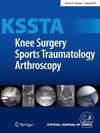Partial weight-bearing and range of motion limitation significantly reduce the loads at medial meniscus posterior root repair sutures in a cadaveric biomechanical model
Abstract
Purpose
The aim of this study was to investigate the influence of medial meniscus posterior root avulsion (MMPRA) before and after surgical treatment on the biomechanics of the knee joint, including suture repair forces during daily and crutch-assisted gait movements.
Methods
MMPRA were investigated in eight human cadaver knee joint specimens by a dynamic knee joint simulator with daily (normal gait, gait with additional rotational movement, standing up, sitting down) and rehabilitation-associated movements (crutch-assisted gait with limited flexion range of motion [30°] and 30% [toe-touch weight-bearing, TTWB] and 50% of body weight [partial weight-bearing, PWB]) with simulated physiologic muscle forces. Each specimen was tested in intact, torn and repaired (transtibial suture) state. The biomechanical parameters were: medial mean contact pressure and area, knee joint kinematics, medial displacement of the posterior meniscus horn and loading on the anchoring suture.
Results
Significant reduction of the contact area due to the avulsion was observed in all movements except for PWB and sitting down. MMPRA repair significantly increased the contact areas during all movements, bringing them to levels statistically indistinguishable from the initial state. MMPRA resulted in a medial displacement up to 12.8 mm (sitting down) and could be reattached with a residual displacement ranging from 0.7 mm (PWB) to 5.7 mm (standing up), all significantly (p < 0.001) reduced compared to the torn state. The mean peak anchoring suture load increased from TTWB (77 N), PWB (91 N) to normal gait (194 N), gait rotation (207 N), sitting (201 N; p < 0.01) and to standing up (232 N; p = 0.03).
Conclusion
Surgical treatment of MMPRA allows restoration of physiological knee joint biomechanics. Crutch-assisted movements reduce the loading of the repair suture, thus likewise the risk for failure. From a biomechanical point of view, crutch-assisted movements are recommended for the early rehabilitation phase after MMPRA repair.
Level of Evidence
Level V.


 求助内容:
求助内容: 应助结果提醒方式:
应助结果提醒方式:


